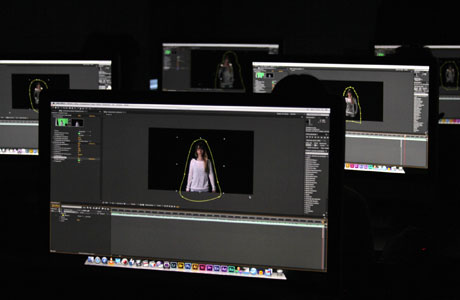Courses
Chroma post-production course April 2014
Layer compositing by chroma key combines compositing, lighting and color correction disciplines. If we want the viewer not to notice the integration, technical and artistic elements have to be taken into account, ranging from the suppression of dominant colors in the actors’ skins to the unification of lighting and camera angle between background and main layer.
In this chroma key compositing course we will study the different techniques used in different applications to compose chroma key compositing. Far from being a course on the handling of a particular tool, the course teaches the philosophy of integration independently of the application, allowing the student to complement the chroma key lighting course if desired.
PROFESSOR: José Carlos Panadero
José Carlos Panadero. Adobe Certified Instructor. Apple Mentor Trainer. Post-producer in spots for Coca Cola, Chevrolet, Hyundai or Mercedes. You can see some of these spots in this link on vimeo
DURATION: 5 hours.
PRICE: 100€ (90€ if you book before April 24th). You can get up to 20% discount if you sign up for several courses. Discounts are not cumulative.
WHEN: Monday, April 28th. Schedule: from 16h to 21h (may vary slightly).
WHERE: CES Audiovisual Campus. You have all the information about how to get there here. If you need any kind of information you can contact 709 MR by email or telephone (668840783).
EQUIPMENT USED: After Effects and Mocha AE on Apple professional workstations, one per student.
COURSE CODE: PCR20-280414
AIMED AT: Directors of photography, camera operators, data management, DIT’s, camera assistants, colorists, post-producers, editors, directors, post-production directors, production directors, filmmakers and in general video and photography professionals who want to learn how to postproduce for chroma key integration.
PREVIOUS KNOWLEDGE: Basic cinematographic knowledge.
CONTENTS
1.-Introduction
- Uses of chroma keying techniques.
- Color, resolution and image compression issues.
2.-Composition
- Composition theory with chromas.
- Layers and transparency.
- Masks, gourds and other extraction tools.
- Rotoscopy with Mocha.
- Refine the chroma key.
3.-Integration
- Color correction.
- Overrun suppression and elimination of dominants.
- Color matching.
- Surrounding light.
4.-Tracking and matchmoving
- Motion analysis for chroma integration.
- Tracking 2D with Mocha and 3D with After Effects.
- Null objects.
- Flat surfaces with Mocha
For a more in-depth knowledge of how to pre-produce and illuminate the material to be embedded, you can take the Chroma Lighting course before this one.
You can download the documentation for the course here
For any further information please contact us at info@709mediaroom.com.


